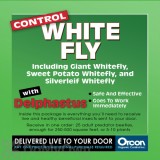Delphastus Pusillus
USE: Delphastus is a small, glossy, black beetle, that is a quarter size of a ladybug that feeds on several species of whiteflies including greenhouse, avocado whitefly and sweet potato (silverleaf). If whiteflies do not exist, they will also feed on spider mites. The adult beetle and the larvae are predators and will eat eggs and larvae of the whiteflies, but not adults.
RELEASE: The Delphastus Pusillus should be released in the evening when it is the coolest, soon after sundown. Mildly shake them out of the container where the whitefly infestation is present. If it is too cool during the release they will not be very active, but their activity will rise as the temperature increases. Be cautious on the first shake that they do not all come out. If direct release is not possible, keep them in a cool place but do NOT refrigerate.
COVERAGE: Normal coverage is 1 beetle per 10 to 25 square feet of area that is planted, or up to 50 square feet in outdoor landscapes. One container, 25 beetles, should cover about 250 to 500 square feet.
LIFE CYCLE: The Delphastus beetle is all black (males have brown heads). The adults live between 69 to 90 days and the female will lays eggs in clusters of 8 to 12, and produce 50 groups every two days, depending on food that is available. The eggs that are clear hatch into light green/yellow larvae and will eat between 100 and 200 eggs of whiteflies per day. After 2 or 3 weeks they will make a cocoon and then emerge 6 days later as an adult. The adults are proficient to eat over several hundred larvae and eggs per day of whiteflies.
RECOMMENDATIONS: The release of the Delphastus must be at the first signs of whiteflies. Their activity increases with warmer temperatures, but adults can tolerate temperatures between 45 and 100 degrees. The most affected areas should be pruned before their release to be more beneficial. Wiping down with summer or mineral oil (food grade) is also valuable before their release. Soapy water can be used as a substitute. This process may be repeated after 30 days.
GENERAL INFORMATION: Delphastus may be used with other whitefly parasites and predators such as Green Lacewings and Encarsia Formosa and be used at the same time. Whiteflies usually do most of its damage at the top of the plant, and will notice that the Delphastus intuitively move toward the top of the plant in their search for food.

